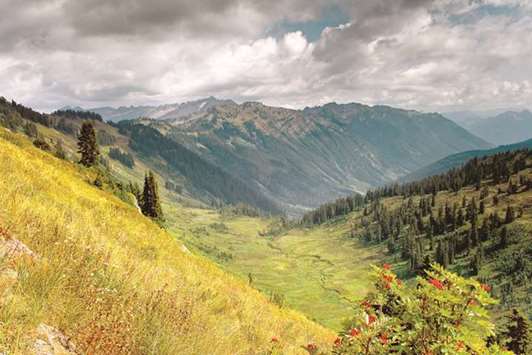some of the hazards you might encounter while hiking the Pacific Crest
Trail from one end of the United States to the other. By Ute Wessels
A 4,280-kilometre path, a 20-kilogram rucksack, six months and one daunting goal: to make it to the other side. Every year, some 3,500 people attempt to hike the Pacific Crest Trail (PCT) in the US. Far from all of them make it. The long-distance trail from the Mexican to the Canadian border requires not just time off from work or school, but also mental preparation for a long and painful slog.
In a holiday apartment in Wrightwood, near Los Angeles, 52-year-old Eugen from Munich is carefully applying plasters to his foot. He began his PCT journey four weeks ago from the border area of Campo in the southern US.
The doctor has taken time off from his job for this trek: “After 25 years of working, turning off the mobile phone for six months and completely relaxing” is how he pictured this going.
He had heard about the trail years ago and decided that he wanted to try it some day. “The idea seemed completely crazy, but at the same time it totally gripped me,” he says.
He has been marching about 35 kilometres a day, with a few breaks in between. On large stretches of the trail, hikers will see no houses, no streets, no shower, no stores, often for days - which means carrying and rationing one’s food and water well.
Sources of water are scarce in southern California, and failing to bring enough to drink could put your life in danger. There is also no mobile phone signal for long stretches - but there are forest fires, rattlesnakes and, farther north, bears. The season starts in April, when it’s not yet too hot in southern California, especially the Mojave Desert, and not too wintery in the High Sierras.
Those who can’t handle the daily mileage won’t make it in time to reach their goal - the hiker has to make it to Canada before the end of September, before there is too much snow cover.
Eugen has just spent two rest days in Wrightwood, picked up his rations at the post office and is about to set off again. Has he thought of giving up?
“Yes, absolutely. Like most people.” At night, trekkers pitch their tents, enjoy some soup and crawl into their sleeping bags. The nights on this part of the trail are cold and uncomfortable. Water condenses in the tents, clothes get damp, the body starts to ache.
And in the morning it starts all over again. Over and over. Ten days later, as Eugen is taking a break in the desert city of Tehachapi, he meets two other Germans. Marieke and Jan are sitting in a bakery, where there is coffee and cinnamon rolls, all-important calories! It’s nearly impossible for trekkers to eat enough to make up for all the calories their bodies are burning while on the trail.
Marieke learned about the PCT from the film Wild, starring Reese Witherspoon. “After that, I was set on hiking the trail,” says the 22-year-old. She prepared with a friend on a tour through Norway. After getting through the first blisters, the two are now on a roll.
“You have to stay constant and want to or force yourself to want to, trek at least eight hours every day,” says Marieke, a student. The three Germans start the next section together. It goes into the High Sierra. A late winter makes hiking more difficult. Fields of snow start to melt as the day goes on, and the hikers sink with every step, sometimes up to the hip. In addition, there are a tonne of rivers and streams that must be crossed.
With wet feet, they straggle on. Several weeks later, Jan decides to give up. The pair are not going fast enough to reach Canada in time. Forced breaks, due to an injury on Marieke’s part and a package containing essential gear going missing, cost them precious time.
He has simply lost his desire to hike. “The feeling of having already seen the most beautiful and interesting part, the High Sierra. On top of that, few comforts, no toilets, always the same food.” Marieke wants to go on alone, as far as she can make it until the autumn weather arrives.
And Eugen? After the High Sierra, ‘an unforgettable experience’, he decided to take a break at Mammoth Lakes. He’s been on the move for 10 weeks now, has lost several kilograms, and his feet and joints ache.
One last time, he gathers himself together and packs. His goal is no longer Canada, but the 1,000-mile mark. He lacks the motivation to sleep in a tent for another three months, eating just granola bars and soup, while the best, and hardest, part is already behind him. He doesn’t see this as a defeat, however, “because ‘only’ 1,600 kilometres by foot through complete no man’s land is also a crazy route.” – DPA

FAST PACE: Hiking the pacific Crest Trail involves walking at least 35 kilometres per day. Those who walk slowly don’t reach Canada by winter even.

ASSOCIATED RISK: Sources of water are scarce in southern California, and failing to bring enough to drink could put your life in danger.



